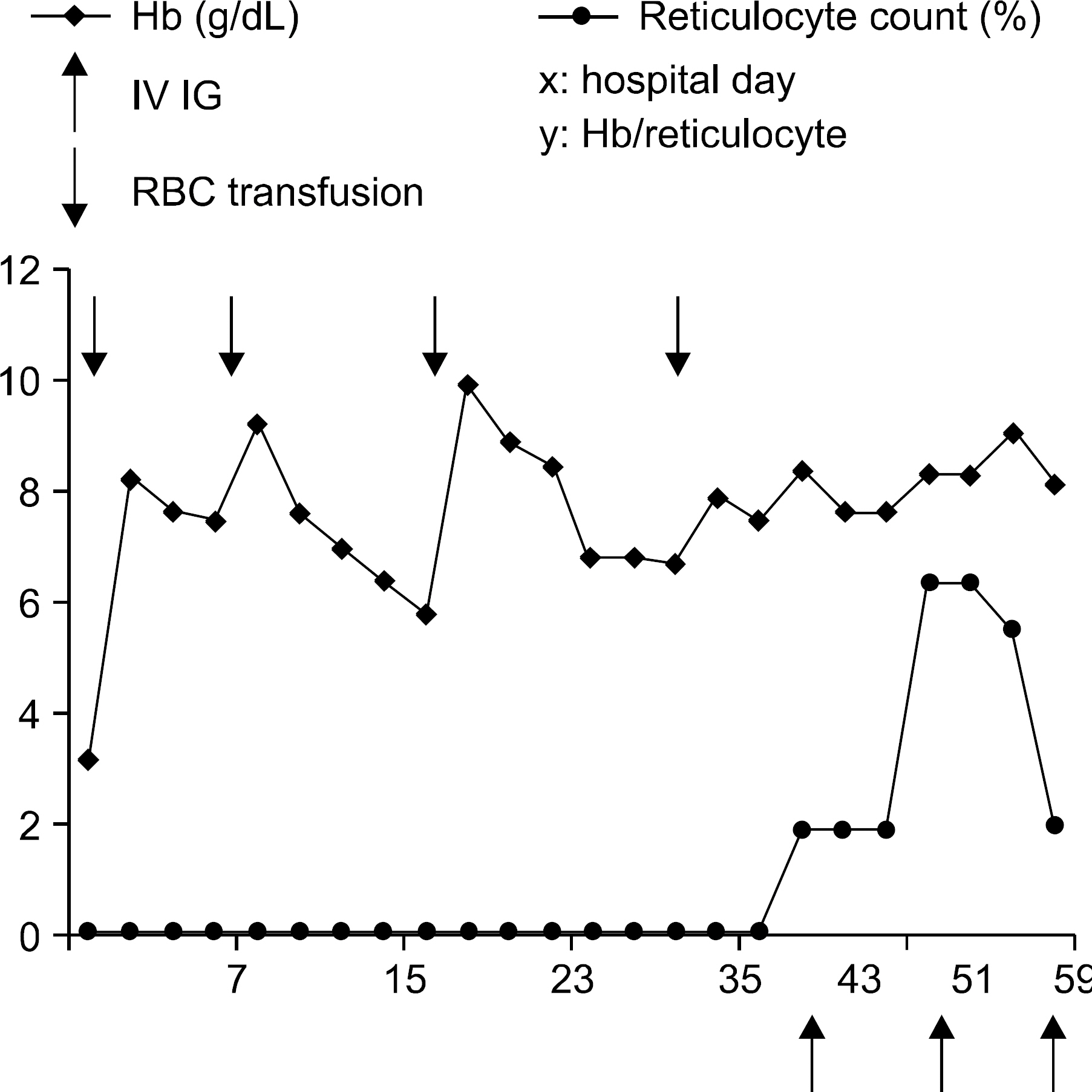Korean J Hematol.
2007 Sep;42(3):283-287. 10.5045/kjh.2007.42.3.283.
A Case of Immunoglobulin Therapy for Pure Red Cell Aplasia Induced by Parvovirus B19
- Affiliations
-
- 1Department of Internal Medicine, College of Medicine, Hallym University, Chuncheon, Korea. hemonc@hallym.or.kr
- 2Department of Laboratory Medicine, College of Medicine, Hallym University, Chuncheon, Korea.
- KMID: 2305204
- DOI: http://doi.org/10.5045/kjh.2007.42.3.283
Abstract
- Human parvovirus B19 infection could be manifested as pure red cell aplasia or chronic anemia in immunocompromised host. The patient was 35-year-old female who had been diagnosed as non-Hodgkin lymphoma, peripheral T-cell unspecified type and had been performed chemotherapy. She complained headache and dizziness that was found to a marked drop in hemoglobin (3.2g/dL). A bone marrow aspiration revealed findings consistent with erythroid hypoplasia with maturation arrest. Serum parvovirus B19 PCR and anti parvovirus B19 IgM were positive. After immunoglobulin therapy, it was leading to a marked increase in reticulocyte count and corresponding rise in hemoglobin. To our knowledge, this is the first report to use immunoglobulin in an adult cancer patient with pure red-cell aplasia. Human parvovirus B19 infection should be considered in immunocompromised cancer patients with red cell aplasia and early use of immunoglobulins would be helpful in resolution of anemia and not to delay planned chemotherapy.
MeSH Terms
-
Adult
Anemia
Bone Marrow
Dizziness
Drug Therapy
Female
Headache
Humans
Immunization, Passive*
Immunocompromised Host
Immunoglobulin M
Immunoglobulins*
Lymphoma, Non-Hodgkin
Parvovirus B19, Human
Parvovirus*
Polymerase Chain Reaction
Red-Cell Aplasia, Pure*
Reticulocyte Count
T-Lymphocytes
Immunoglobulin M
Immunoglobulins
Figure
Reference
-
1). Brown KE., Anderson SM., Young NS. Erythrocyte P antigen: cellular receptor for B19 parvovirus. Science. 1993. 262:114–7.
Article2). Anderson LJ. Human parvovirus. J Infect Dis. 1990. 161:603–8.3). Pamidi S., Friedman K., Kampalath B., Eshoa C., Hariharan S. Human parvovirus B19 infection presenting as persistent anemia in renal transplant recipients. Transplantation. 2000. 69:2ㅌ. 666–9.
Article4). Frickhofen N., Abkowitz JL., Safford M, et al. Persistent B19 parvovirus infection in patients infected human immunodeficiency virus type 1 (HIV-1): a treatable cause of anemia in AIDS. Ann Intern Med. 1990. 113:926–33.5). Koduri PR., Kumapley R., Valladares J., Teter C. Chronic pure red cell aplasia caused by parvovirus B19 in AIDS: use of intravenous immunoglobulin-a report of eight patients. Am J Hematol. 1999. 61:16–20.
Article6). Isobe Y., Sugimoto K., Shiraki Y., Nishitani M., Koike K., Oshimi K. Successful high-titer immunoglobulin therapy for persistent parvovirus B19 infection in a lymphoma patient treated with rituximab-combined chemotherapy. Am J Hematol. 2004. 77:370–3.
Article7). Song KW., Mollee P., Patterson B., Brien W., Crump M. Pure red cell aplasia due to parvovirus following treatment with CHOP and rituximab for B-cell lymphoma. Br J Haematol. 2002. 119:125–7.
Article8). Ghazal H. Successful treatment of pure red cell aplasia with rituximab in patients with chronic lymphocytic leukemia. Blood. 2002. 99:1092–4.
Article9). Batlle M., Ribera JM., Oriol A., Plensa E., Milla F., Feliu E. Successful response to rituximab in a patient with pure red cell aplasia complicating chronic lymphocytic leukemia. Br J Haematol. 2002. 118:1192–3.10). Lee YJ., So BJ., Chae KM., Jeong BH. A case of pure red cell aplasia due to parvovirus B19 in renal transplantation. Korean J Hematol. 1999. 34:646–50.11). Park AJ., Lim YA., Jeon HS, et al. A case of transient aplastic crisis induced by human parvovirus Bl9 in hereditary spherocytosis. Korean J Hematol. 1996. 31:313–8.12). Jung HJ., Kim EC., Cho HI, et al. Chronic hypoplastic anemia caused by human parvovirus B19 in a patient with non-Hodgkin's lymphoma. Korean J Lab Med. 1993. 13:587–94.13). Brown KE. Parvovirus B19. Mandell GL, Bennett JE, Dolin R, editors. Mandell, Douglas, and Bennett's principles and practice of infectious diseases. vol. 2. 6th ed.Philadelphia, USA: Elsevier Churchill Living-stone;2005. p. 1891–8.14). Koch WC., Adler SP. Detection of human parvovirus B19 DNA by using the polymerase chain reaction. J Clin Microbiol. 1990. 28:65–9.
Article15). Brown KE., Hibbs JR., Gallinella G, et al. Resistance to parvovirus B19 infection due to lack of virus receptor (erythrocyte P antigen). N Engl J Med. 1994. 330:1192–6.
Article16). Erdman DD. Human parvovirus B19: laboratory diagnosis. Anderson LJ, Young NS, editors. Human parvovirus B19. Vol. 20. Monographs in virology. Basel, Switzerland: Karger;1997. p. 93–104.
Article17). Koduri PR., Kumapley R., Valladares J., Teter C. Chronic pure red cell aplasia caused by parvovirus B19 in AIDS: use of intravenous immunoglobulin-a report of eight patients. Am J Hematol. 1999. 61:16–20.
Article18). Subtirelu MM., Flynn JT., Schechner RS., Pullman JM., Feuerstein D., Del Rio M. Acute renal failure in a pediatric kidney allograft recipient treated with intravenous immunoglobulin for parvovirus B19 induced pure red cell aplasia. Pediatr Transplant. 2005. 9:801–4.
Article
- Full Text Links
- Actions
-
Cited
- CITED
-
- Close
- Share
- Similar articles
-
- Parvovirus B19-induced Pure Red Cell Aplasia in a Liver Transplant Recipient
- Drug-induced hepatitis complicated by pure red cell aplasia and autoimmune hemolytic anemia: a case report
- A Case of Pure Red Cell Aplasia Due to Parvovirus B19 in Renal Transplantation
- A Case of Pure Red Cell Aplasia Due to Parvovirus B19 Infection in a Renal Transplant Recipient
- Pure Red Cell Aplasia Due to Parvovirus B19 in Renal Transplants



